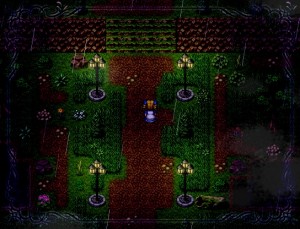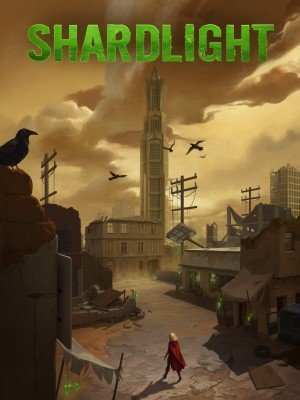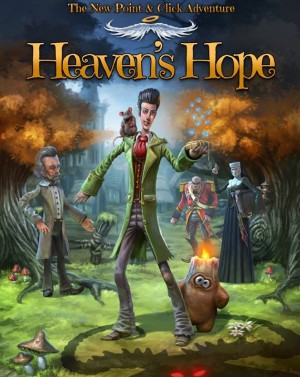Bob Bates - Thaumistry: In Charm’s Way interview
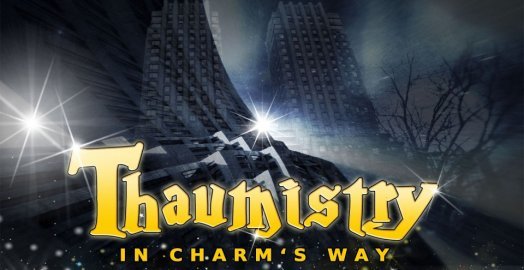
Following our exclusive announcement of his new text adventure game earlier this month, acclaimed industry veteran Bob Bates has now launched his Kickstarter campaign for Thaumistry: In Charm’s Way. Originally called Bodgers, Thaumistry marks Bob’s welcome return to his Interactive Fiction roots and the heyday of Infocom. While our previous interview with Bob contained an in-depth look back at his impressive past, it’s time now to look ahead to a bright future as we discuss his upcoming magical comic fantasy adventure over a decade in the making.
Ingmar Böke: Welcome back, Bob! By the time our readers get their hands on this interview, Thaumistry: In Charm’s Way (formerly known as Bodgers) will be live on Kickstarter. Please describe the game and its story in your own words.
Bob Bates: Hi! Thaumistry is a brand-new, full-sized comedy text adventure game, a game that I think we would have been proud to publish at Infocom or Legend Entertainment. Thaumistry is very much in the style of the games we were doing at that time, so it will be very familiar to the fans of both companies.
It’s a modern comic fantasy set in New York City. The player character is named Eric Knight, and he is a magic user, but doesn’t know it. Things kind of go wrong when he’s around. Computers turn off when he enters a room or doorknobs fall off in his hand when he tries to use them. Odd things are happening, and in the first scene of the game somebody comes in and says, “maybe this is happening because you may – secretly – be a user of magic.” The other people like you are called Bodgers, and throughout the course of the game you explore your identity as a magic user, and decide whether or not you’re in fact a Bodger or want to be a Bodger.
The immediate threat, though, is that the existence of Bodgers is about to be exposed, which would be a very bad thing for them because people in the non-magic world have traditionally reacted to magic users in very nasty and mean ways, even though Bodgers only use magic for good. A Bodge is like a kludge or a hack, and a Bodger’s goal is to make some small thing go wrong so that some big thing will go right; a small mishap that will turn into something that’s of great benefit for a lot of people.
Ingmar: This might seem like an unusual genre to tackle in 2017 after working on many big projects following your text adventure days. What motivated you to start Thaumistry?
Bob: Parser-driven games have a unique charm to them. They’re fun to play, and fun to make. When you work on a big AAA project, there are potentially hundreds of people working on the game. It’s a huge collaborative process, which has its own joys and rewards, but it’s a very different experience than making a text adventure game. Making a game like Thaumistry is an intensely personal experience. The way I see it is that it’s just me and the player on the other side of the screen, and we’re talking back and forth to each other. I like to think of the player imagining there’s this little guy in the box who’s talking back to him, and that guy is me.
It’s hard to have a personal connection with the designer of a AAA game. You know, when you’re playing Call of Duty, Assassin’s Creed, Battlefield or any of the huge games, as a player you don’t feel as if you’re talking with the designer or as if you’re in the same room with him. A parser-driven game, though, feels very open-ended. You can type anything you want, and create any input you want. Often the fun of these games is that you’ll think of something that’s kind of odd or crazy to try, and you’ll probably expect to get a default reply like “you can’t do that” or something like that. But when you make one of these strange inputs, if the author has anticipated that, and gives you a joke as a reward, that’s a unique and wonderful feeling.
I feel like we lost out in the industry when we went away from the parser. Brian Moriarty, another Infocom designer, used to say that, “in a AAA game you can only write what you can afford to show, and you can’t afford to show much.” So, in a big game, the cost for giving the player rewards for off-beat inputs is huge, while in a text game the cost is slight as you only need a few minutes and a bit of creativity, and suddenly you’ve got an interaction that somebody is really gonna enjoy. Throughout the course of doing all of these AAA games and Facebook games, I found they have their rewards, but they’re different kinds of rewards for me as a game maker. I just love making text adventures, and I just love sitting down, imagining what the player might want to try that isn’t the solution to a puzzle, but that he thinks will be fun, and then to give him that reward of making it fun is something I really enjoy.
There’s one more thing this style of game can have (others can too, but, again, they’re much more costly): there’s a much greater opportunity for depth of character for the non-playable characters. When it comes to non-playable characters in a role-playing game or in an action game, as a game designer you often don’t have the opportunity to give them the kind of depth that you would find in a novel or something like that; in a text adventure you can! You can learn about the backgrounds of characters and find out why they have done what they’ve done, and that’s a qualitatively different experience than a AAA action game.
Ingmar: What you just said brings back some of my earliest adventure game memories. I was born in 1981, and one of my first adventure games as a kid was the original version of Leisure Suit Larry 1, which contained a text parser. Keep in mind that I grew up in Germany, so this was before my friends and I had English classes in school. We were playing the game with the help of a dictionary, you know, and were just trying to type in all kinds of stuff we came up with. I remember some of the most rewarding things for us were responses to things we typed in even though they were not related to the main plot or any puzzles.
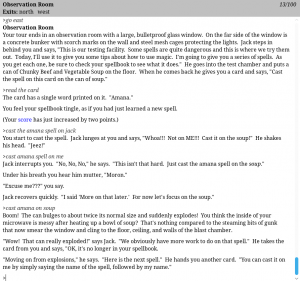 |
Nothing but good old-fashioned, high-interaction text adventuring in Thaumistry |
Bob: Yeah, and that’s huge fun for the player and the designer, too. You know, I’m sitting there saying, “what are they gonna try?” Let’s say I’ve given them a hammer, and they’re in a room with a window. Somebody’s going to try throwing the hammer through the window. It’s not going to be the solution to a puzzle, but somebody is going to try it, so you want to reward players for it. Especially when there are puzzles in a game, the player is going to spend much more time doing things that aren’t the correct solution to a puzzle than he does doing things that are the right answer. It’s my job to entertain the player while he’s not solving puzzles, and that’s great fun.
Ingmar: How do you plan to avoid the limited parser responsiveness that plagued even Infocom somewhat back in the day?
Bob: I think a lot about that. First, one of the best ways to handle that problem is to anticipate, so I put in all kinds of synonyms, all kinds of different combinations of verbs and nouns that will make an action come true, that will make the input successful. Let’s say you’re going to “give the sword to the knight.” You could also say “give sword to knight,” “give knight sword,” “knight, take the sword,” “throw the sword to the knight,” “throw the sword at the knight,” “show the sword to the knight,” “show the knight the sword.” So all of those inputs are things I’m trying to code from the beginning.
Then you put the game in the hands of testers, which I have done one round already with Thaumistry. I had twenty people play the game for a month in 2016. I get their transcripts, and I go line by line through the transcripts. When I see an input that should have worked, I say, “oh, I need to handle that.” So if somebody came up with a combination, and they obviously knew the answer to the puzzle, and typed it but the game didn’t recognize it, that’s my fault, so then I go back and code it so that interaction will work.
Another thing that I routinely do is I put in lots of misspellings for a word, so that the game won’t punish you if you just misspell something. Again, when I look at the testers’ transcripts, anytime the game says “I don’t understand that word,” I look at the spelling and add that spelling as a synonym, so that the game will understand it. I do that as much as I can. So it’s a combination of anticipating things and being very diligent with the testers’ transcripts.
One thing that has changed since the days of Infocom is that at that time typing was a real barrier because people didn’t type, and didn’t know how to type. Now almost everybody knows how to type, everybody’s interacting with their computers, and even if they’re just two-finger typists, people are used to interacting via a keyboard, and that’s a huge difference from 25 years ago. So the players themselves are going to have an easier time with Thaumistry, and I take a lot of care in making it so players don’t have to fight the game to get done what they want to do.
Ingmar: Sounds like a lot of work!
Bob: It is, but that kind of work isn’t that hard because it is easy to see, “oh, this person put two ‘r’s into this word instead of one.” People don’t have to be great spellers as the game takes take care of them.
Ingmar: The main character Eric learns how to use spells and magic. How are you implementing this element into the game?
Bob: This is a great example of what we were just talking about. As you go through the world, sometimes you just stumble upon a spell and it automatically goes into your spell book, while sometimes it’s a puzzle to acquire a spell. Once a spell is in your spell book, you can often just type the name of the spell. There are some spells that you just cast in a room, and it has an effect; some other spells you just cast on people or on things, so you can often just type the name of the spell and the person or object you want to cast it on.
Let’s say that there is a spell called Abracadabra, so you might just type “abracadabra” and something interesting happens, or instead you might type “cast abracadabra on Jack,” “cast the abracadabra spell on Jack” or “abracadabra Jack.” So again, lots of different combinations of verbs and nouns that will make that thing happen. But basically, apart from the mechanics, you find spells in the game, you solve puzzles to acquire spells, and then you cast the spells in the appropriate situation to solve puzzles. Most of the puzzles in the game – not all of them – are solved by the inventive use of spells.
Ingmar: Before this interview, you sent us a description of the game and some of its features, so I know that a museum expo plays an important role in Thaumistry. And having read your booth descriptions, they are hilarious! Please share some info about the expo, its booths, and how they’re connected to the overall experience.
 |
A sampling of Thaumistry's spell selection |
Bob Bates: When the game starts, the player is in his lab, feeling kind of dejected, and then this character comes in who says, “Hey, you are probably a magic user, and don’t know it, so we should really give you the opportunity to learn more about that. But we have this problem: our existence is about to be exposed to the world. There’s this inventor who has invented a machine that can detect units of magical energy, which are called 'thaums.' He died a few years ago, but all of the inventions he was working on were brought to the Museum of Innovation. They’re on display there, and we can’t get at them, but one of his inventions, when it’s turned on later today, will detect magical energy and will reveal that we exist. We can’t have that, but there are some reasons why we can’t take care of it. But you’re an inventor yourself, and we feel like you may be able to do it, so can you help us out?”
So, you go to this museum, and it’s almost like a trade show for inventors; an inventor’s expo, basically. Think of gamescom, E3 or something like that where the inventors have come to show what they have invented and attract investors to back them. In the course of the game you encounter these inventors, and their very interesting, strange, and hopefully funny inventions. In some cases their invention isn’t quite working yet, and it becomes a puzzle to help them make it work. And once you make make their special thing work, you can use it to solve other puzzles in the game. Of course, I tried to make the inventions do funny things, so hopefully it will work out that way.
Ingmar: I know this a tough question, but can you give a rough idea of your goal when it comes to the game’s length?
 |
A little more Thaumistry charm in all its "graphics-free glory" |
Bob: Not really, because there are different styles of playing a game like this. I see it in my testers’ transcripts all of the time, and of course I know this from the time we made the original games: some people only want to solve puzzles and go through the game as fast as they can. Other players want to absorb the atmosphere, want to try interesting things and poke around, and see what this game world has in it. And then a third kind of player is very interested in the characters, and they want to spend time talking with the characters and learning about their histories and backgrounds, and why they do what they do. So I created content for all those styles of gameplay. People who want to explore every nook and cranny, or who want to really get to know the characters, can do that, and of course that takes longer than simply solving the puzzles.
So I don’t really have an answer to your question other than to say Thaumistry is probably a little bit longer than Eric the Unready, and probably shorter than TIMEQUEST. (laughs) That’s probably the best way to answer that question, but of course it only means something to people who played those games. It’s a big game. A lot of the interactive fiction that we’ve seen in the last 15 years – and some of it has been great – is short. There aren’t many games that are more than 2-3 hours; Thaumistry is definitely more than 2-3 hours!
Ingmar: We talked about a lot of older games in our first interview. Are there any recent games that impress you when it comes to their storytelling?
Bob: Certainly, the Uncharted series is a stand-out. The characters in there are well-drawn, and they’re funny and engaging, and you want to interact with them, but you can’t because most of what you get is through very well-written cutscenes. This goes back to Moriarty’s rule, you know, because they’re so successful they can afford to show hours of cutscenes, but the budget for those games is enormous, and the time it takes to create them is huge. But I mean, your question was what current or recent games do great storytelling, and in the AAA space, Uncharted is definitely my most recent favorite.
Ingmar: Thanks a lot for taking so much time for Adventure Gamers over the course of two extensive interviews. It was a real pleasure! Before we finish, please feel free to share some last words with potential backers of Thaumistry: In Charm’s Way.
 |
The man himself: Bob Bates |
Bob: First, I need to say thank you! I don’t spend a lot of my time looking backwards, and it might seem strange for a guy who’s doing text adventures in 2017, but I don’t. I don’t spend a lot of time thinking about those days and those games, and sometimes when people ask me about some of those things, I’m like, “I have no idea, I don’t remember that at all.” (laughs) It’s really nice that there are people who are still interested in those games, and who still like to talk about them. That’s a nice feeling for me!
When it comes to players who think about pledging to our campaign: I had the first idea for this game 12 years ago. I took the first notes on an airplane flight, and I still have them. It has taken a really long time to pull this game together, to learn the development system, to learn how to code things, to be able to get to the point where I had the confidence that I could actually deliver this game. I didn’t want to approach the gaming community with this, and ask for money, before I was certain that I could in fact deliver. It was around two years ago when I realized, “yes, this is definitely something that I can get done and deliver.”
It would probably seem strange to people who say, “if you self-funded this for so long, why are you coming to the game community now, asking for support?” The answer is partly for the opportunity to do ports, to do technical work that I can’t do myself. I don’t have the technical skills to do an iOS port, an Android port, bring the game to the Kindle. Also, I don’t have the skills to create sound effects, and I can’t compose the music.
But the other reason is to get the game out. The time that I have to work on the game has always been basically nights and weekends, because I have a full-time job. If the Kickstarter community supports Thaumistry: In Charm’s Way, I can get the game done faster and better. It means that I can turn down contracting work, and work on Thaumistry instead.
Ingmar We certainly wish you all the very best with the Kickstarter campaign. Thanks again, Bob!
Bob: Thanks a lot to Adventure Gamers and your readers for keeping the flame alive. It is a good flame!







